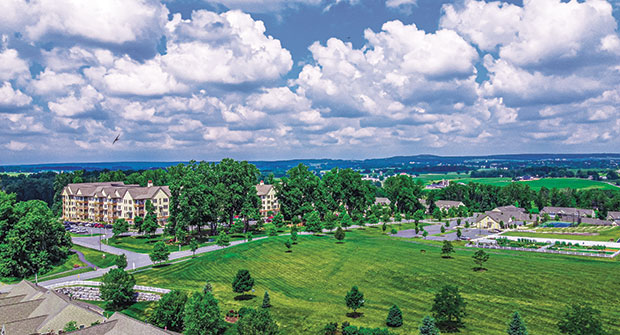
If asked to describe the Ruppert Landscape, an attendee of NALP’s Field Trip might use adjectives such as “decentralized” and “transparent.”
Host venue Ruppert Landscape puts a strong emphasis and empowerment on its many branches through its decentralized approach to its structure.
More than 260 tourgoers got a chance to see Ruppert Landscape’s Laytonville, Md., operation up close during the day-and-a-half event, held Sept. 1-2 in Gaithersburg, Md. Frank Mariani, CEO of Mariani Landscape, and Marty Grunder, CEO of Grunder Landscaping Co. and The Grow Group, served as guides.
“There wasn’t a detail that wasn’t covered,” Grunder said.
Craig Ruppert, CEO, said having his company serve as a host site for this field trip was important. He acknowledged he and his leadership team have brought back many things by attending past field trips.
“All we’re doing is paying back what’s been done for us,” he said.

Human resources and training
With numerous branches and an employee base nearing 2,000, Courtney Pohlit, vice president of people and recruiting, said she’s challenged to “make our big company feel smaller.” This includes reinforcing the Ruppert culture and keeping employee engagement high. Ruppert again puts a lot of the day-to-day management on branches, which handle pay raises and evaluations.
“We provide the guidance and the guardrails for our branch managers,” Pohlit said.
One success Ruppert has found with employee recruitment is what the company calls a “sphere of influence.” Ruppert emphasizes finding its next employee through a current employee.
“The best people come as a referral,” Ruppert said.
Ruppert has streamlined its onboarding process through new videos and offers educational opportunities to all employees. Mike Monde, director of culture and training, said Ruppert focuses on each new hire’s first 10 days. This includes having new employees wear orange vests so Ruppert team members can easily spot new hires.
Multicultural training is a newer initiative for the company. Ruppert’s workforce is about 46 percent Hispanic. Monde said the company wants to promote its next generation of leaders from within.
“We are trying to change the complexion of the company,” Monde said.

Fleet management and safety
Greg Franklin, director of fleet and facilities, said his department is the most centralized at Ruppert. Fleet and facilities are in charge of the purchase and maintaining of assets, not branch managers. The company buys Exmark mowers, Ford F450 dump trucks and Isuzu trucks and works to keeps the fleet looking new by extending the life of the equipment. Ruppert tries to keep trucks between 12 to 15 years, and with aluminum bodies, the company hopes to extend trucks to two generations.
Ruppert is currently testing battery-powered trailers for its fleet of battery-powered equipment. The company uses Echo, Stihl and Husqvarna handheld equipment. Franklin said the company is also testing battery-powered equipment from Makita and Ego, and this is dictated by customers.
The company recently developed a hybrid dump and cargo box truck for its Arlington, Va., branch to better fit on the narrow streets of the city.
Ruppert Landscape also takes safety seriously, and the company works hard to prevent accidents.
“The easiest accident to manage is the one you don’t have,” said Adrian Karver, regional safety manager for Ruppert Landscape.
Ruppert works with drivers to reduce risk and encourage safe driving. A Lytx drive cam tracks what’s going on inside and outside the cab. The safety team at Ruppert can access recordings following any hard breaks or other triggers, and then the video is a teaching tool to reduce unsafe behavior behind the wheel.

Landscape and construction management
When asked to describe the culture of Ruppert Landscape, Tom Barry, president of Ruppert Landscape’s landscape management division, said “we are a ‘work hard, play hard company’ and entrepreneurial at the branch level.”
Labor is undoubtedly a big challenge for the company. Barry said he hopes one day to have potential employees lined out the door. And although labor is one of Ruppert Landscape’s biggest challenges, the company internally promoted 22 of its 23 landscape maintenance branch managers. The company employs more than 200 people related in one way or another. Phil Key, president, said that’s a good sign that the company is doing something right.
“How flattering is it when someone said my son or daughter wants to work here?” he said.
Pricing is another challenge Ruppert faces with contracts. Jason Dixon, director of business development for Rupert’s landscape management division, said “as an industry, we are guilty of driving prices down” and a challenge Ruppert Landscape faces is to maintain price integrity. Dixon said clients continually ask why maintenance contracts have a yearly increase.
Dixon said he explains these increases by sharing how the company provides stable wages for employees, acknowledging a tight labor market and how the company sees price increases for materials.
Mariani said companies like Ruppert need to stress the benefits the green industry provides and why that service comes at a premium.
“What we do is so great for homeowners and property owners for sustainability and the economy.We need to charge more,” Mariani said. “How can you cut prices when you don’t have the labor to do the job?”
Ruppert Landscape often bids on landscape construction projects that are complex and multiscope as there’s less competition, said Bob Jones, president of Ruppert’s landscape construction division.
When selecting projects that aren’t attached to a branch, Ruppert Landscape looks for a landscape construction branch with the bandwidth to take on the project. Crew members who staff the project volunteer to travel, and the company pays them a per diem and flies crews home every three weeks to visit family.
“A lot of guys get excited to go to a place to work,” Key said.

